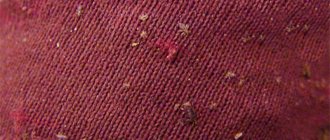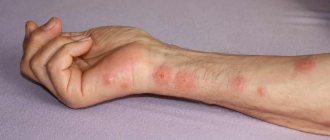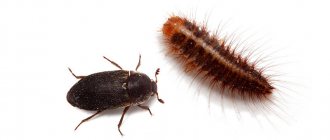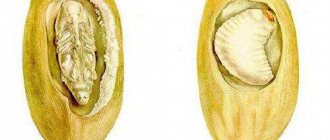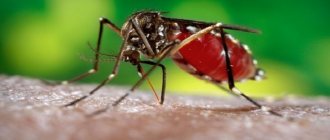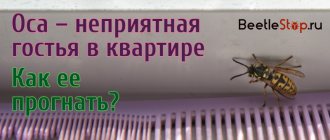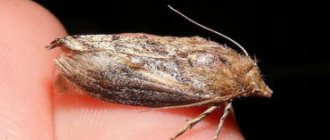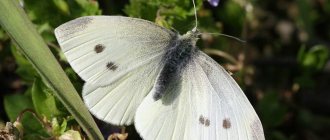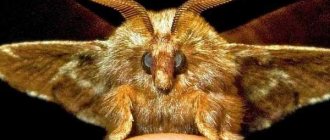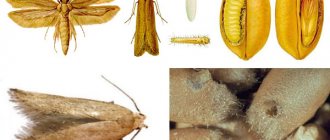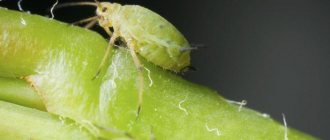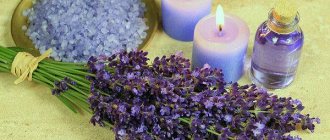Few people know what a book louse looks like and how to get rid of it at home forever. If your apartment has an old library, supplies of dried grass, herbariums or old furniture, then the risk that you will get unwanted neighbors in the form of colonies of these parasites is great. It is no coincidence that the second name of this insect is hay beetle. These small pests feed on organic plant debris and book binding paste.
The book louse is an insect of the order of hay-eaters.
How can hay eaters get into an apartment?
Book and dust lice are cosmopolitan. They live on all continents, but are especially common in the southern regions. Due to their small size, getting inside the premises is not difficult for them. And window and door openings, ventilation holes and all kinds of cracks are great for this. Sometimes hay beetles are brought into an apartment with things or objects already infested with them. For example, with a book or a bag of cereal. But not every home will have them for a long time. After all, for them, like for any other living organisms, acceptable conditions for existence are extremely important.
Reasons for appearance
Hay eaters feel most comfortable at a temperature of 25–35 o C and an air humidity of 75% or higher. However, often when these indicators decrease, insects are in no hurry to leave their habitable places. The reason for this is due to additional factors that deter insects.
Hay eaters are attracted not only by dampness, but also by the mold on which they feed. A flooded basement or leaking roof can be the cause of an infestation of hay beetles on the first and last floors. Defects in waterproofing, obvious or hidden leaks in pipes, ceilings, closed structures - all these are possible causes. High humidity and, as a result, mold are also almost always present in corner apartments. Sometimes seam joints in panel houses allow moisture to pass through, be it rain or snow. The formation of mold behind the wallpaper may not yet be noticeable, but this is already enough for hay beetles to appear.
Mold is food for hay eaters and the reason for their appearance in the house
Hay eaters love casein glue
Book lice often appear in old books.
Grains and cereals are acceptable food for hay eaters
Hay eaters feed on plant remains and herbariums are completely suitable for this
Indoor plants are a source of high humidity and mold, which hay eaters really like
Harmless Inhabitant
Today, science knows 1,700 species. A good half of hay eaters live in the tropics and subtropics. They are considered harmless inhabitants of forest trees and shrubs; they can be found in the ground under stones, in bird nests.
Tropical guest in our homes
The nutritional base of insects is lichens, organic remains, green algae, molds, and dust.
They spoil food supplies, carpets, and furniture. From observations it was found that buckwheat is preferable for them.
Harmless book louse
Household pests are two types of hay beetle: book louse, brownie (dust louse).
Book hay eater
This insect is small in size (1 mm). It can be pale brown, sometimes white. The book louse is completely devoid of wings.
The book louse lives almost everywhere.
Dusty Hayeater
This louse is slightly larger - up to 2 mm. The dusty hay beetle differs from the book beetle in the presence of rudimentary wings. It also differs in color. This is a light yellow insect with reddish spots forming longitudinal stripes on the upper part of the abdomen.
This photo will help you recognize the difference between book lice and dust lice.
It lives in similar places as the book hay eater.
Insect physiology
The hay eater's jaws are not developed enough to handle solid food. To crush it, they use a stick, which is located on their head. Expertly, with the skills of an experienced carpenter, hay eaters break off pieces of grains with a kind of hammer, after which they are eaten. At night, you can hear the sounds of measured tapping made by their hammers.
House subspecies of insects
These little creatures do not refuse other food. Old books with natural bindings that contain paste and casein glue suffer from their activities.
Most often they breed in pots of indoor plants. If there are any in rooms where conditions are favorable for hay eaters (moisture, poor lighting), they need to be removed from these places.
Biological features
The eggs of the hay beetle develop without fertilization. The female can lay up to 100 eggs. The ovipositor can be solitary or in small groups. The clutches are covered with secretions from the rectum, which, when dry, form tiny scales, or are covered with a light web secreted by a characteristic spinning organ on the lower lip and uvula.
One generation develops in 3-4 weeks. Up to 6 generations are produced per year.
In addition to the fact that, having settled in a person’s home, the hay beetle harms things and food supplies, it poses another danger.
Hay eater: what kind of insect is it?
In tropical forests and subtropical zones you can often find a small representative of the fauna with two pairs of colorless wings, sometimes covered with dark spots, which fold on the abdomen when stationary. The size of these insects does not exceed 1 cm, but more often it ranges from 0.6 to 7 mm. Hay eaters, as representatives of this order are called, are, in biological terms, insects with incomplete metamorphosis. This means that their life cycle consists of only three stages: eggs, larvae and adults. Moreover, the larvae are externally similar to adult individuals, they are, as it were, a smaller copy of them and lead a lifestyle similar to the imago.
Some species of hay beetles have two pairs of colorless wings with thin veins
The order of hay eaters is very heterogeneous. Currently, scientists have studied more than 5 thousand species. This number includes 120 fossil remains found during paleontological expeditions. Outwardly, many species are not similar to each other, and sometimes even have more similarities with representatives of other orders. One of the clearest confirmations of this is the presence or absence of wings. In some species they are shortened, in others they are completely absent. Senoyeds are also characterized by sexual dimorphism, which is expressed in the fact that females of winged species can be either short-winged or completely wingless. Males have enlarged spherical eyes and antennae densely covered with hairs.
Certain species of hay eaters are more similar in appearance to representatives of other orders - Lice and Lice Eaters
In the wild, each species chooses the most suitable conditions for itself. This could be the bark or crowns of trees, nests of birds or other insects, dead wood or forest litter. There are even species that live under rocks. But almost always the best habitat is the presence of lichens nearby, which provide both a home and food for insects. Some species have adapted to the human environment. The most widespread are the book louse (Liposcelis divinatorius) and the house louse (Trogium pulsatorium).
In the wild, hay beetles live mainly in places with an abundance of lichens, remains of plant and animal origin
Book louse
This species is the smallest representative of the order. Its dimensions are about 1 mm. The body is light, almost white with a yellowish or slightly brown tint, flattened in the dorsal and ventral parts, slightly widened and rounded at the back. The head is quite large. The antennae are longer than the head, gradually tapering towards the edges. Wings are completely absent.
In nature, they most often live in rodent burrows and bird nests. The food consists mainly of various remains of animal and plant origin, wood dust, rotting leaves, terrestrial algae, molds and parasitic fungi. Living tissues of higher plants are consumed extremely rarely.
Hay eater eggs can develop without fertilization, which contributes to the rapid reproduction of individuals. During the day, the female lays from 60 to 100 eggs: one or several at a time. Each clutch is covered with intestinal secretions, which dry out to form scales and perform a protective function. The larvae emerging from the eggs sometimes unite in groups, creating common web nests, or lead a solitary lifestyle. At a temperature of 16–35°C, the life cycle of hay beetles is 3–4 weeks. In one year, up to six generations are reproduced in natural conditions, and in domestic conditions, which are optimal, insects develop continuously.
Book louse is a small insect of pale brown or white color.
Dust louse, or house louse
A species close to the book louse. It differs only in morphological features. In appearance, this insect is light yellow in color with reddish-brown stripes on the upper part of the abdomen.
Dust louse is a light yellow insect with longitudinal stripes on the upper part of the abdomen
In addition, the dust louse is slightly larger than the book louse and reaches 2 mm in size. It also has appendages to the rear wall of the body - rudimentary wings.
Best articles: Beautiful nicknames for girl rats. What name to choose for a decorative rat?
Externally, the dust louse differs from the book louse in being larger in size.
Characteristics
The hay beetle is a small insect (up to 10 mm) with two pairs of colorless wings. Sometimes they may have dark veins or inclusions.
The diversity of species of this beetle explains possible external differences between individuals. Some hay eaters have shorter wings than usual or no wings at all.
Visually, male pests differ from females by the presence of:
- antennae with hair.
- Large spherical eyes.
One of the varieties of insect is the book louse, which is often found in human-inhabited areas.
How to get rid of hay eaters in an apartment
Book and dusty hay beetlesWays to combat hay beetles
Hay eaters are small insects that resemble a louse in appearance, some of them have underdeveloped wings. Hay eaters live up to their name by preferring to eat dry plant materials. But when they get into a person’s home, they do not neglect many valuable items.
Appearance, habitat
There are about 1,700 species of hay beetles in the world. Their main population lives in tropical forests. They settle on tree branches, in a layer of fallen leaves, in rotten stumps, bird nests - wherever there are dry plant remains. They prefer a humid climate and moderately warm temperatures.
Within our country there are two types of these insects:
- book louse or book louse - a small insect 1 mm in size, light brown or white in color, without wings;
- dusty hay beetle or dusty louse is an insect about 2 mm in size, has small rudimentary wings, the color of the body is light yellow with small red spots.
The hay beetles in the photo are often found on many Internet sites about pests. These insects prefer to settle in damp warehouses, cellars, archive rooms, and libraries. They are often pests of cereals, especially buckwheat. They can live in pots of indoor flowers and feed on fallen leaves or particles of humus in the soil.
Book and dusty hay eaters
Nutrition
In the wild, hay beetles prefer to settle in dark hollows, stumps, and animal burrows, where there is soft bedding in the nests and optimal temperature and humidity are maintained. They can often be found in thickets of lichen, moss, and among moldy fungi.
When insects enter granaries or warehouses, they spoil the grains by gnawing out their core, thereby making them unsuitable for further use. Once in an apartment, book and dust lice can spoil cereal supplies.
Their main delicacy is dry vegetation; insects find them in dried herbs, herbariums, and dried flowers. Hay eaters are often found in libraries and paper archives, eating book bindings and paper rot.
Reproduction
The main breeding ground for hay beetles in human homes is flower pots. The female can lay up to 100 eggs at a time, which will turn into larvae in 3-4 weeks. An insect can lay eggs 6 times in a year. Such fecundity in favorable conditions can increase the number of pests to huge colonies.
If you don’t start fighting hay eaters at home in a timely manner, they can populate every corner of the apartment and cause serious consequences.
Ways to fight
Ways to combat hay eaters
Hay eaters in an apartment are a serious problem, and you need to approach it wisely. To begin with, you can resort to gentle measures to eliminate them:
- regularly sort through cereals in boxes and bags, dispose of expired bulk products in a timely manner;
- wipe down bookshelves and inspect books for pests;
- monitor the soil in flower pots, remove fallen leaves and thin out the soil;
- Ventilate the apartment periodically.
These simple methods will help prevent the appearance of book and dust lice. When they do appear, you should know how to get rid of hay eaters in your apartment. If their habitat is a container with cereals, you need to throw out the contents and sort through the neighboring cereals. Treat desk drawers with cleaning agent.
If insects are found in a book, it should be wrapped in cellophane and placed in the freezer for a few minutes.
If book lice have appeared on many books, you need to collect all the literature in a bag and take it out to the cold in winter or to a hot, ventilated place in summer.
To remove parasites on a production scale, special means are used:
- generation of cold or hot fog - an installation that sprays artificial fog mixed with toxic substances;
- steam generation – thermal treatment of premises;
- applying wet chemicals to surfaces.
Such processing of industrial premises or public libraries is carried out by employees of special sanitary services
Working with toxic drugs requires special care and protective measures
Harm
The brownie hay beetle has no detrimental effect on human health, but its presence can have a detrimental effect on valuable things:
- on old stale literature in libraries or on bookshelves in the house;
- on archival documents;
- in herbariums;
- on entomological collections;
- on food stocks.
The insect gnaws through the spines of books containing old glue and dried plants. And if the warehouse or barn is humid (this is the atmosphere that is comfortable for book lice) and the grains are stored for a long time without moving, the insect will happily gnaw through the grains, making its way to their embryos, after which there will simply be nothing to sow on the fields.
In nature, the hay beetle feeds on lichen, mushrooms, and in rare cases, living plants.
Ways to combat woodlice and silverfish
Before treating the apartment with one or another insect repellent, it is necessary to restore order, clean the room, ventilate it well, wash the plumbing and pipelines, sewer pipes, floors, walls and furniture. You also need to seal all the cracks and gaps. Only after this can you begin to destroy parasites in the bathroom. There are several ways to do this.
- Physical methods. After general cleaning, all objects in the room, including the walls and floor, must be treated with a chlorine-containing agent, and after drying, apply a solution of copper sulfate. You can also use various traps and baits. For example, leave wet birch brooms, a roll of paper or jars with a lump of sugar in the corner overnight, and throw them away in the morning. Insects will definitely come for something sweet and wet.
- Chemicals. Aerosols (Raid, Raptor, Dichlorvos) for killing insects can destroy uninvited guests in one month if they are sprayed weekly throughout the apartment and especially in the bathroom. During the procedure, you need to wear protection on your hands and face - a mask and gloves, and after treatment, wash all objects that come into contact with your hands, as well as the bathtub and sink.
- Folk remedies. To combat silverfish and woodlice, our grandmothers treated dark places with diatomaceous earth. Zest shavings and spices, especially cloves, are very disliked by crawling creatures. You can also wash furniture and plumbing with water and essential oils of lavender or citrus fruits; their smell will drive away pests. Boric acid should be applied to the pipeline, sink, and toilet.
Best articles: Is a snake a reptile or an amphibian?
To get rid of annoying insects in the bathroom forever, you need to take a whole range of different measures:
- remove excess moisture with a fireplace or heater;
- arrange good ventilation;
- regularly ventilate the bathroom;
- thoroughly wipe off dust even in hard-to-reach places;
- regularly sanitize the premises with a chlorine-containing product.
Such small, long insects are able to move very quickly on their numerous legs, penetrating into the narrowest crevices. They instantly hide when the light is turned on. Silverfish multiply quite quickly, so they pose a problem for apartment owners.
Their diet includes various substances: wallpaper paste, mold fungi, book bindings, sugar-containing products, fabrics and leather (not synthetic), food scraps and even wet paper and rags. Due to their nocturnal lifestyle, silverfish are difficult to spot immediately.
These gray-white beetles appear from dampness and choose corners with high humidity to live. They are not dangerous for humans: they do not bite due to their too small mouth, and they do not spread bacteria.
Silverfish and woodliceMost often, small, almost flat, small bugs can be seen in the bathroom and toilet. This is a common silverfish. They come in white, pearl gray or brownish color. Immediately after molting, they are almost transparent, later becoming darker. The shape resembles an elongated triangle. Long thin antennae protrude from one and the other side of the small body (4-8 mm).
You can get rid of them by creating conditions unacceptable for life and reproduction. They thrive at temperatures between 21°C and 27°C and high humidity—above 75%. They feed on substances containing starch and polysaccharides. They usually enter residential premises with paper, napkins and other paper products. In homes they can eat bread, sugar, fabrics, flour, glue, photographs, etc.
One of the most common insects found in the bathroom is silverfish.
These insects will disappear in the bathroom only if they have nothing to eat and the room is dry and light. To reduce humidity, it is recommended to eliminate all leaks, dry all wet places (you can use a hair dryer), carefully seal the joint between the bathtub or shower tray and the wall, fill all the seams between the tiles with grout, fill all joints and cracks with silicone, and organize ventilation by installing a fan if necessary. Having completed these works, thoroughly wipe off the water after any procedures.
Role in the ecosystem[edit]
The Yadrena Louse is a significant link in the ecosystem. It limits the number of people, promoting the spread of the forest. Musical Yadren Lice make the population of Russia stupid, so only citizens of Tajikistan receive the profession of woodcutter. But, nevertheless, citizens of Tajikistan (after living on the territory of the Russian Federation for a short period of time) become citizens of Russia. Consequently, the number of citizens of Tajikistan on the territory of the Russian Federation is decreasing. Consequently, there are fewer loggers. Consequently, the territory of forest and forest-steppe zones on the territory of the Russian Federation is increasing. Order.
Basics of life
Insects reproduce relatively quickly. Depending on humidity, access to a food source and temperature conditions, this indicator reaches maximum heights. In one day, a sexually mature female can lay up to 60 eggs, which is quite enough for the development of an entire colony. The lifespan of adults depends on the same indicators. If everything goes well, they can easily live up to 53 weeks. Moreover, although hunger is a fundamental factor in life, it is not capable of killing parasites immediately. They can tolerate it calmly for a long time.
How to deal with the pest?
There are very few traditional methods of fighting book louse, but there are a large number of mechanical methods for exterminating them. If such parasites are found in books, then they need to be put in a plastic bag and taken out into the cold (if it is winter) or into the sun (in summer). If pests appear in only one or a few books, they can be placed in the freezer for 20-30 minutes.
If it is necessary to destroy insects in storage facilities or in a warehouse, it is necessary to deliberately lower the temperature of food supplies, heat the grain and clean the room.
There are many chemical destruction methods that will help get rid of parasites:
- use of hot fog generation;
- carrying out wet disinfestation;
- generating cold fog.
The choice of extermination method depends on the area of the room in which the treatment will be carried out. For large spaces, cold fog generators are used. In addition, fumigators with hot steam are often used. If you need to treat a person’s suburban dwellings, experts recommend using liquid insecticides (wet disinfestation). To carry out this procedure, substances of toxicity groups III or IV are recommended.
Another way to get rid of dust lice in warehouses is to use low-toxic products based on synthetic peritroids. Such drugs do not pose any harm to human health. This group of substances includes Flitsid, which quickly paralyzes insects. If there are a lot of book lice, then you need to treat household items and the room several times.
In addition, there is a group of insecticides based on avermectin. Such drugs cause the death of adults, as well as clutches of larvae. These means include:
- Akarin;
- Vertimek.
A number of drugs based on permitrin are highly effective:
- Tolkord;
- Permasect;
- Ambush;
- City;
- Corsair.
Dust lice will disappear if they are treated with the following means:
- Microcin;
- Arrivo;
- Nurel.
These drugs are highly effective and have a long-lasting effect, and are also characterized by safety and the absence of a bad odor. Note that with the help of chemical treatment of book hay eaters, you can quickly get rid of these parasites. However, it is necessary to adhere to all safety measures when performing the procedure. Work only with gloves, goggles and protective clothing. At the end of this process, it is necessary to ventilate the room and carry out wet cleaning after 2-3 days.
Knowing how to get rid of such parasites, you can quickly and effectively remove them. This will allow you to leave the books safe and sound, and will also protect your reserves of grain and cereals.
https://youtube.com/watch?v=J0PhiKM6CRA
Insect locations
Before you start fighting hay eaters, you need to figure out where these uninvited guests come from.
Best articles: The most terrible animals in the world - names, descriptions and photos
In the wild, insects are often located in places where they can get enough food for themselves:
- A layer of fallen leaves.
- Bird's nests.
- Rotten stumps.
- Trees, bushes.
The comfortable existence of bugs is ensured by a moderately warm, humid climate, as well as the presence of dry plant residues.
In the apartment
Hay eaters in an apartment are not a very common occurrence.
However, the small size of the bugs allows them to easily enter the home using many methods:
- doorways.
- Gaps between the wall and the window frame.
- Ventilation shafts.
- Any cracks.
However, this fact does not guarantee an unpleasant neighborhood. The lack of conditions comfortable for the existence of a family of bugs forces them to look for a more suitable home.
In a new building
The idea that pests only like old buildings is completely wrong.
Hay eaters may well settle in new block buildings, which is explained by the following:
- elevated temperature.
- Air humidity comfortable for insects (about 75%).
The combination of these factors contributes to the development of mold, which book lice use as their main food. In addition, they are attracted by the smell of tile grout, casein glue, etc.
In the kitchen
Having settled in the kitchen, hay eaters actively begin to destroy dry food products. To make sure that dust lice are present, it is enough to carefully examine everything that makes up the pests’ favorite diet - cereals and grains.
If any are found on cereals, the latter are spoiled and unsuitable for cooking. Grain after exposure to hayworms should also be thrown away.
In the bathroom
The appearance of bugs in the bathroom is due to constant dampness. Air temperatures from 27 to 35 degrees, as well as high humidity (more than 75%) contribute to the development of mold, which attracts hay eaters.
Under the floor
Residents of the first floors often encounter beetles under linoleum.
The reasons for this are as follows:
- basement flooding.
- Leaks in pipes (both obvious and invisible to the eye).
- Poor quality waterproofing.
If the apartment is located in a panel house, wet rainy weather can lead to moisture penetration through the joints.
How dangerous is a body louse?
The fight against parasites should begin from the moment the bite is noticed. If this is not done, the wounds turn into pustules at the first stage, and the next stage is boils and ulcers. Subsequently, scars remain on the body.
By biting through the skin during a bite, the parasite injects an anesthetic secretion that prevents blood clotting. The bites are accompanied by severe itching, and in a dream a person scratches the wounds, which causes them to bleed. Severe damage causes excoriation. Regular bites cause roughening and thickening of the skin, and its color changes - yellow-brown.
The main danger from a bitten parasite lies in the transmission of infections:
- quintan;
- relapsing fever;
- typhus.
There are cases when pyoderma develops. You can read more about this disease in the article on photos, treatment and symptoms of pyoderma.
Attention! By crushing an insect on your body, you can become infected. Since fluid from the abdomen enters the blood vessels through the wound.
Synanthropic species of hay beetles
There are only two types of hay beetles that are domestic parasites:
- book louse (also called book louse);
- brownie (also called dust louse).
These types of pests have managed to fully adapt to living in residential areas. However, they can also be found in nature.
As for the book hay beetle, in nature it prefers to settle in bird nests and rodent burrows. Typical food of the pest is the remains of plant and animal origin. Accordingly, in a human home such an insect prefers places closest to food sources. For example, various types of plant collections or zoological collections can attract a parasite that will cause serious damage to them in a short period of time. Thus, the parasite often appears in museums and libraries.
Harm of the hay beetle to humans
The microclimate of a human apartment or house is very comfortable for the pest. Favorable conditions contribute to stable reproduction. Several new generations of the parasite appear each year. It is also worth noting a unique feature of the reproduction of the hay beetle: the eggs do not require fertilization, they develop independently and turn into viable offspring.
Once settled in an apartment, the parasite can cause significant damage to a person’s belongings:
- First of all, herbariums and hunting collections come under attack; the damage may be partial, but the hay eater can completely destroy the item;
- it is easy to guess that the book louse targets books and albums that suffer irrevocably;
- stocks of dried herbs will be completely swept away if pests get to them;
- dust louse spoils food products such as flour, grain and cereals.
The main problem is not even that insects destroy food, but that they leave waste products in it (excrement, scales after molting). Such food can no longer be consumed by humans.
Barns, warehouses and similar premises suffer from insect attacks. The parasite gnaws out the embryos of grain crops, which become unsuitable for planting.
Prevention of the appearance of hayworm
Preventative measures against hayworm in commercial and private premises should be carried out regularly. This will either completely prevent the appearance of insects or stop their reproduction on the site.
We list the main preventive measures:
- You cannot place grain, flour and other products in storage until it is checked. Pre-inspect the premises thoroughly, identify possible contamination, and carry out preventive cleaning and disinfection.
- Before storing grain, clean it of foreign impurities and dry it.
- Maintain a low air temperature in the place where dry products are stored; this is an unfavorable environment for the pest.
- Product control must be carried out constantly: check grain samples for the presence of pests.
- A good additional preventative measure would be to spray stocks with insecticides.
If we talk about living quarters, then prevention is expressed in regular inspection of herbariums and other plant and zoological collections, eliminating dust on objects, organizing ventilation, maintaining normal humidity in the room.
What types of lice are there?
There are quite a large number of varieties of lice. Some of them are able to live only on animals, and some on humans. But despite the large number of lice, their specificity is that a certain species can live only on one type of host. In other words, human lice are unable to survive on other mammals, with the exception of some species of monkeys. It is worth noting that fleas, unlike lice, are capable of parasitizing various types of animal hosts.
The human louse spends its entire life cycle on or near the host's body. The main and only source of its nutrition is blood.
There are 3 types of lice that parasitize the human body:
- head;
- linen or clothes;
- pubic.
Types of lice
The head louse's habitat is the hair on the head. Occasionally in men they can parasitize the beard. They tend to change their color after feeding. The gray-brown color becomes more saturated due to the blood in the stomach of the individual. An adult parasite can reach 4 mm, and the eggs it lays range in size from 0.6-2 mm. The larvae can be seen on the hair 2-3 cm from the scalp. Favorable conditions for life and reproduction are temperatures of about 30°C. The head louse dies at temperatures below 0°C or above 45°C. When washing your hair, lice, like nits, are not removed. You can get rid of them by cutting your hair completely (headless) or using special shampoos and medications.
The linen louse has a light yellowish-gray color. It is similar in size and build to the head one. It feeds on blood, although it lives only on clothing, which is in constant contact with the human body. The carriers of such parasites are most often homeless people who do not observe personal hygiene rules and do not change their clothes.
Pubic louse
The body louse lays its eggs where it lives, on clothing. Therefore, getting rid of it is not difficult. It is enough to throw away or boil things and wash the body thoroughly.
Pubic louse affects the groin hair area, eyebrows and eyelashes. The size of an adult does not exceed 2 mm, its larvae - no more than 0.5 mm. In appearance, the insect is brown in color with a flat body shape. It can only be seen in more detail under a magnifying glass or microscope. Most often, infection occurs through sexual contact, but the possibility of domestic infection, such as using someone else's clothes or swimming in a pond, cannot be ruled out.
